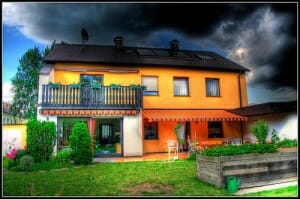
Exterior painting contractors are often challenged by the varying conditions and requirements posed by exterior painting projects. Through the years, the lessons learned at each completed project have advanced the paint technology. As a result of these advances, today’s exterior paints cater to nearly every condition ever encountered during exterior painting project implementations.
Location-Driven Paint Considerations
Your Athens painting contractor and paint manufacturers agree that one of the most common conditions that often have to be met when it comes to exterior painting projects is the one dictated by location. Geographical differences are apparent in construction styles and material preferences. Location therefore dictates the selection of exterior paint to be used.
For instance, the Southwest is the home of masonry and stucco exteriors. These substrates require primers and top coats appropriate for cementitious materials. In the Southeast, weather-resistant formulations are used by exterior painting contractors to withstand year-long exposure to wind and rain. In mountainous locations, on the other hand, sun-resistant and UV-absorbing resinous formulations are used.
Weather-Proof Exterior Coatings
Paint manufacturers have also developed formulations to cater to another major factor influencing projects – the weather. Climatic variables surrounding the project are considered by Athens exterior painting contractors when selecting the products to use. It even influences the application and methods that they can use.
Climates that produce high levels of UV rays are often applied with elastomeric-based or 100% acrylic paints for surface protection. Windy and rainy weather are applied with thicker-film elastomeric to combat water-borne cracks.
Air temperatures lower than 50ºF can lead to surface chalking and premature peeling, while above 90ºF can severely affect surface preparation, application and curing. Athens exterior painting contractors must keep this in mind during the project. Freezing-thawing cycles, on the other hand, require flexible primers and topcoats to cope with the fluctuating temperatures.
The Environment’s Role in the Choice of Exterior Coatings
Federal and local laws on environmental protection have influenced the design and manufacture of exterior coatings. Paints with the low-VOC formulations have been introduced. This aims to halt the harmful effects of VOC-emitting regular paints to the environment.
Athens painting contractors and paint manufacturers must comply with the U.S. Environmental Protection Agency’s (EPA) VOC-level standards at the national level. In the north east and mid-Atlantic states, the Ozone Transport Commission (EPA) Model Rule is in place. State-based air quality programs also watch strictly over VOC compliance that covers the building industry.
Compliance to these varying environmental regulations and agencies resulted in new formulations of exterior coating products for architectural, commercial and industrial painting. These are often low-VOC latex, water-borne or solvent alkyd products.
In 2012, a law shifting the building industry to the use of water-borne coatings will be in full effect. A significant change in favor of the environment, exterior painting contractors keep this in mind as they choose products for their existing and future coatings projects.
The factors above often dictate the choice of exterior coating products to use in Athens exterior painting projects. Yet exterior painting contractors often advise building owners to continue to seek the balance between meeting these conditions and choosing the best-performing product for their projects.
Article Source: https://EzineArticles.com/?expert=Steve_A._Parker